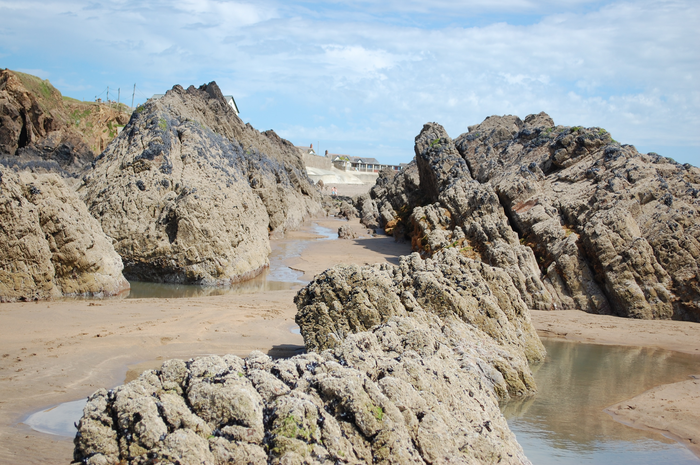A temperature increase of around 1.5°C – just under the maximum target agreed at the COP23 Paris meeting in 2017 – can have a marked impact on algae and animal species living on UK coastlines, new research has found.

Credit: University of Plymouth
A temperature increase of around 1.5°C – just under the maximum target agreed at the COP23 Paris meeting in 2017 – can have a marked impact on algae and animal species living on UK coastlines, new research has found.
The study, by ecologists at the University of Plymouth, examined how increases in rock surface temperature were affecting the quantity and behaviour of species commonly found on the shorelines of Devon and Cornwall.
It focused on two sites on the region’s north coast (at Bude and Croyde) and two on the south coast (Bantham and South Milton Sands), all of which have deep gullies with both north-facing and south-facing surfaces.
Their findings showed the average annual temperature on the south-facing surfaces at low tide was 1.6°C higher than those facing north and that temperature extremes (i.e. > 30°C) were six-fold more frequent on south-facing aspects.
Across the four sites, these differences had a significant effect on species abundance with 45 different species found on north-facing sites during the summer of 2018 compared to 30 on south-facing ones.
In winter, the figures were 42 and 24 respectively, while some species – including the red seaweed Plumaria plumosa and sea cauliflower (Leathesia marina) – were restricted to north-facing surfaces.
The different temperatures also had an impact on species’ breeding patterns with five times more dog whelk (Nucella lapillus) eggs found on north-facing surfaces than south-facing ones.
And while limpet reproduction generally occurred earlier on south-facing surfaces, these key grazers also exhibited greater levels of stress.
The research, published in Marine Environmental Research, is the first to explore the association between temperature and site geography on species abundance, physiology and reproductive behaviour in coastal areas.
Its authors say it provides evidence of how temperature variation at local scales can affect species while also offering an insight as to how future changes in global temperatures might have a negative impact over the coming decades.
The research was led by Dr Axelle Amstutz as part of her PhD, working alongside Associate Professor of Marine Ecology Dr Louise Firth, Professor of Marine Zoology John Spicer, and Associate Professor in Plant-Animal Interactions Dr Mick Hanley.
Dr Hanley, the study’s senior author, said: “We have all heard for some time about the importance of limiting average global temperature increases to 1.5°C, and it will undoubtedly be one of the key topics discussed at the forthcoming COP26 conference. This study shows the impact even that kind of increase could have on important species that contribute to the health and biodiversity of our planet. As such, it does add to overwhelming evidence of the threats posed by human-induced climate change.
“However, more than that, it shows how the pressure on different species can change even within individual locations. For example, we recorded a temperature of 42.5°C on a south-facing surface at Croyde at the same time as 22.5°C was measured on the opposite north-facing side. We believe this shows such sites can be used as a ‘natural laboratory’ to inform and predict how species and habitats might respond to climate change over the coming decades.”
Journal
Marine Environmental Research
DOI
10.1016/j.marenvres.2021.105482
Method of Research
Observational study
Subject of Research
Not applicable
Article Title
Facing up to climate change: Community composition varies with aspect and surface temperature in the rocky intertidal
Article Publication Date
20-Sep-2021




